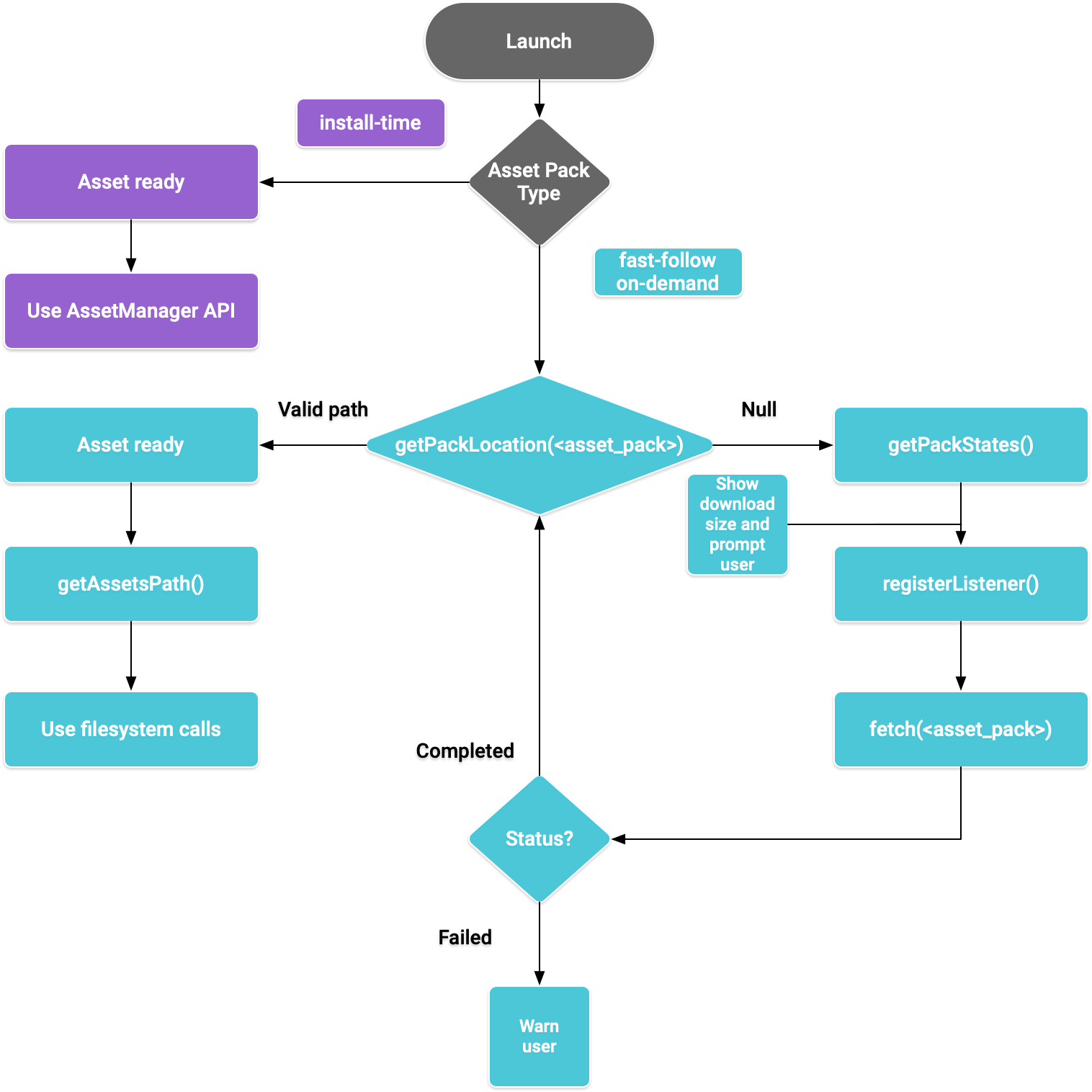请按照本指南中的步骤,通过 Java 代码访问您应用的资源包。
为 Kotlin 和 Java 构建
请按照以下步骤将 Play Asset Delivery 构建到您的项目 Android App Bundle 中。您无需使用 Android Studio 即可执行这些步骤。
将您项目
build.gradle文件中的 Android Gradle 插件版本更新到4.0.0或更高版本。在项目的顶层目录中,为资源包创建目录。此目录名称用作资源包名称。资源包名称必须以字母开头,并且只能包含字母、数字和下划线。
在资源包目录中,创建
build.gradle文件并添加以下代码。请务必指定资源包的名称和仅一种交付类型Groovy
// In the asset pack's build.gradle file: plugins { id 'com.android.asset-pack' } assetPack { packName = "asset-pack-name" // Directory name for the asset pack dynamicDelivery { deliveryType = "[ install-time | fast-follow | on-demand ]" } }
Kotlin
// In the asset pack's build.gradle.kts file: plugins { id("com.android.asset-pack") } assetPack { packName.set("asset-pack-name") // Directory name for the asset pack dynamicDelivery { deliveryType.set("[ install-time | fast-follow | on-demand ]") } }
在项目的应用
build.gradle文件中,添加项目中的每个资源包的名称,如下所示Groovy
// In the app build.gradle file: android { ... assetPacks = [":asset-pack-name", ":asset-pack2-name"] }
Kotlin
// In the app build.gradle.kts file: android { ... assetPacks += listOf(":asset-pack-name", ":asset-pack2-name") }
在项目的
settings.gradle文件中,包含项目中的所有资源包,如下所示Groovy
// In the settings.gradle file: include ':app' include ':asset-pack-name' include ':asset-pack2-name'
Kotlin
// In the settings.gradle.kts file: include(":app") include(":asset-pack-name") include(":asset-pack2-name")
在资源包目录中,创建以下子目录:
src/main/assets。将资源放置在
src/main/assets目录中。您也可以在此处创建子目录。您应用的目录结构现在应如下所示build.gradlesettings.gradleapp/asset-pack-name/build.gradleasset-pack-name/src/main/assets/your-asset-directories
使用 Gradle 构建 Android App Bundle。在生成的应用 bundle 中,根级目录现在包含以下内容
asset-pack-name/manifest/AndroidManifest.xml:配置资源包的标识符和交付模式asset-pack-name/assets/your-asset-directories:包含作为资源包一部分交付的所有资源的目录
Gradle 会为您生成每个资源包的清单并输出
assets/目录。(可选)如果您计划使用快速跟随和按需交付,请包含 Play Asset Delivery 库
Groovy
implementation "com.google.android.play:asset-delivery:2.3.0" // For Kotlin use asset-delivery-ktx implementation "com.google.android.play:asset-delivery-ktx:2.3.0"
Kotlin
implementation("com.google.android.play:asset-delivery:2.3.0") // For Kotlin use core-ktx implementation("com.google.android.play:asset-delivery-ktx:2.3.0")
(可选)配置您的应用 bundle 以支持不同的纹理压缩格式。
与 Play Asset Delivery API 集成
Play Asset Delivery Java API 提供 AssetPackManager 类,用于请求资源包、管理下载以及访问资源。请务必先将 Play Asset Delivery 库添加到您的项目中。
您根据要访问的资源包的交付类型来实现此 API。这些步骤在以下流程图中显示。

图 1. 访问资源包的流程图
安装时交付
配置为 install-time 的资源包在应用启动时立即可用。使用 Java AssetManager API 访问以此模式提供的资源
Kotlin
import android.content.res.AssetManager ... val context: Context = createPackageContext("com.example.app", 0) val assetManager: AssetManager = context.assets val stream: InputStream = assetManager.open("asset-name")
Java
import android.content.res.AssetManager; ... Context context = createPackageContext("com.example.app", 0); AssetManager assetManager = context.getAssets(); InputStream is = assetManager.open("asset-name");
快速跟随和按需交付
以下部分展示了如何在下载资源包之前获取有关资源包的信息,如何调用 API 开始下载,然后如何访问已下载的资源包。这些部分适用于 fast-follow 和 on-demand 资源包。
检查状态
每个资源包都存储在应用内部存储中的一个单独文件夹中。使用 getPackLocation() 方法确定资源包的根文件夹。此方法返回以下值
| 返回值 | 状态 |
|---|---|
有效的 AssetPackLocation 对象 |
资源包根文件夹已准备好在 assetsPath() 处立即访问 |
null |
未知资源包或资源不可用 |
获取有关资源包的下载信息
应用需要在提取资源包之前披露下载大小。使用 requestPackStates() 或 getPackStates() 方法确定下载大小以及包是否已在下载。
Kotlin
suspend fun requestPackStates(packNames: List<String>): AssetPackStates
Java
Task<AssetPackStates> getPackStates(List<String> packNames)
requestPackStates() 是一个挂起函数,返回一个 AssetPackStates 对象,而 getPackStates() 是一个异步方法,返回一个 Task<AssetPackStates>。AssetPackStates 对象的 packStates() 方法返回一个 Map<String, AssetPackState>。此映射包含每个请求的资源包的状态,以其名称为键
Kotlin
AssetPackStates#packStates(): Map<String, AssetPackState>
Java
Map<String, AssetPackState> AssetPackStates#packStates()
最终请求如下所示
Kotlin
const val assetPackName = "assetPackName" coroutineScope.launch { try { val assetPackStates: AssetPackStates = manager.requestPackStates(listOf(assetPackName)) val assetPackState: AssetPackState = assetPackStates.packStates()[assetPackName] } catch (e: RuntimeExecutionException) { Log.d("MainActivity", e.message) } }
Java
final String assetPackName = "myasset"; assetPackManager .getPackStates(Collections.singletonList(assetPackName)) .addOnCompleteListener(new OnCompleteListener<AssetPackStates>() { @Override public void onComplete(Task<AssetPackStates> task) { AssetPackStates assetPackStates; try { assetPackStates = task.getResult(); AssetPackState assetPackState = assetPackStates.packStates().get(assetPackName); } catch (RuntimeExecutionException e) { Log.d("MainActivity", e.getMessage()); return; })
以下 AssetPackState 方法提供资源包的大小、迄今为止已下载的数量(如果已请求)以及已传输到应用的数量
要获取资源包的状态,请使用 status() 方法,该方法将状态作为整数返回,该整数对应于 AssetPackStatus 类中的常量字段。尚未安装的资源包的状态为 AssetPackStatus.NOT_INSTALLED。
如果请求失败,请使用 errorCode() 方法,其返回值对应于 AssetPackErrorCode 类中的常量字段。
安装
使用 requestFetch() 或 fetch() 方法首次下载资源包,或调用更新资源包以完成
Kotlin
suspend fun AssetPackManager.requestFetch(packs: List<String>): AssetPackStates
Java
Task<AssetPackStates> fetch(List<String> packNames)
此方法返回一个 AssetPackStates 对象,其中包含包列表及其初始下载状态和大小。如果通过 requestFetch() 或 fetch() 请求的资源包已在下载中,则返回下载状态,并且不会启动额外的下载。
监控下载状态
您应该实现一个 AssetPackStateUpdatedListener 来跟踪资源包的安装进度。状态更新是按包分解的,以支持跟踪单个资源包的状态。您可以在请求的所有其他下载完成之前开始使用可用的资源包。
Kotlin
fun registerListener(listener: AssetPackStateUpdatedListener) fun unregisterListener(listener: AssetPackStateUpdatedListener)
Java
void registerListener(AssetPackStateUpdatedListener listener) void unregisterListener(AssetPackStateUpdatedListener listener)
大文件下载
如果下载文件大于 200MB 且用户未连接 Wi-Fi,则下载不会开始,直到用户明确同意使用移动数据连接继续下载。同样,如果下载文件很大且用户失去 Wi-Fi 连接,下载会暂停,并且需要明确同意才能使用移动数据连接继续。暂停的包的状态为 WAITING_FOR_WIFI。要触发 UI 流程以提示用户同意,请使用 showConfirmationDialog() 方法。
请注意,如果应用未调用此方法,下载将暂停,并且仅当用户重新连接 Wi-Fi 时才会自动恢复。
需要用户确认
如果包的状态为 REQUIRES_USER_CONFIRMATION,则下载不会继续,直到用户接受通过 showConfirmationDialog() 显示的对话框。当 Play 无法识别应用时(例如,如果应用是通过旁加载方式安装的),可能会出现此状态。请注意,在这种情况下调用 showConfirmationDialog() 将导致应用更新。更新后,您需要再次请求资产。
以下是监听器的示例实现
Kotlin
private val activityResultLauncher = registerForActivityResult( ActivityResultContracts.StartIntentSenderForResult() ) { result -> if (result.resultCode == RESULT_OK) { Log.d(TAG, "Confirmation dialog has been accepted.") } else if (result.resultCode == RESULT_CANCELED) { Log.d(TAG, "Confirmation dialog has been denied by the user.") } } assetPackManager.registerListener { assetPackState -> when(assetPackState.status()) { AssetPackStatus.PENDING -> { Log.i(TAG, "Pending") } AssetPackStatus.DOWNLOADING -> { val downloaded = assetPackState.bytesDownloaded() val totalSize = assetPackState.totalBytesToDownload() val percent = 100.0 * downloaded / totalSize Log.i(TAG, "PercentDone=" + String.format("%.2f", percent)) } AssetPackStatus.TRANSFERRING -> { // 100% downloaded and assets are being transferred. // Notify user to wait until transfer is complete. } AssetPackStatus.COMPLETED -> { // Asset pack is ready to use. Start the game. } AssetPackStatus.FAILED -> { // Request failed. Notify user. Log.e(TAG, assetPackState.errorCode()) } AssetPackStatus.CANCELED -> { // Request canceled. Notify user. } AssetPackStatus.WAITING_FOR_WIFI, AssetPackStatus.REQUIRES_USER_CONFIRMATION -> { if (!confirmationDialogShown) { assetPackManager.showConfirmationDialog(activityResultLauncher); confirmationDialogShown = true } } AssetPackStatus.NOT_INSTALLED -> { // Asset pack is not downloaded yet. } AssetPackStatus.UNKNOWN -> { Log.wtf(TAG, "Asset pack status unknown") } } }
Java
assetPackStateUpdateListener = new AssetPackStateUpdateListener() { private final ActivityResultLauncher<IntentSenderRequest> activityResultLauncher = registerForActivityResult( new ActivityResultContracts.StartIntentSenderForResult(), new ActivityResultCallback<ActivityResult>() { @Override public void onActivityResult(ActivityResult result) { if (result.getResultCode() == RESULT_OK) { Log.d(TAG, "Confirmation dialog has been accepted."); } else if (result.getResultCode() == RESULT_CANCELED) { Log.d(TAG, "Confirmation dialog has been denied by the user."); } } }); @Override public void onStateUpdate(AssetPackState assetPackState) { switch (assetPackState.status()) { case AssetPackStatus.PENDING: Log.i(TAG, "Pending"); break; case AssetPackStatus.DOWNLOADING: long downloaded = assetPackState.bytesDownloaded(); long totalSize = assetPackState.totalBytesToDownload(); double percent = 100.0 * downloaded / totalSize; Log.i(TAG, "PercentDone=" + String.format("%.2f", percent)); break; case AssetPackStatus.TRANSFERRING: // 100% downloaded and assets are being transferred. // Notify user to wait until transfer is complete. break; case AssetPackStatus.COMPLETED: // Asset pack is ready to use. Start the game. break; case AssetPackStatus.FAILED: // Request failed. Notify user. Log.e(TAG, assetPackState.errorCode()); break; case AssetPackStatus.CANCELED: // Request canceled. Notify user. break; case AssetPackStatus.WAITING_FOR_WIFI: case AssetPackStatus.REQUIRES_USER_CONFIRMATION: if (!confirmationDialogShown) { assetPackManager.showConfirmationDialog(activityResultLauncher); confirmationDialogShown = true; } break; case AssetPackStatus.NOT_INSTALLED: // Asset pack is not downloaded yet. break; case AssetPackStatus.UNKNOWN: Log.wtf(TAG, "Asset pack status unknown") break; } } }
或者,您可以使用 getPackStates() 方法获取当前下载的状态。AssetPackStates 包含下载进度、下载状态和任何失败错误代码。
访问资源包
下载请求达到 COMPLETED 状态后,您可以使用文件系统调用访问资源包。使用 getPackLocation() 方法获取资源包的根文件夹。
资源存储在资源包根目录下的 assets 目录中。您可以使用便捷方法 assetsPath() 获取 assets 目录的路径。使用以下方法获取特定资源的路径
Kotlin
private fun getAbsoluteAssetPath(assetPack: String, relativeAssetPath: String): String? { val assetPackPath: AssetPackLocation = assetPackManager.getPackLocation(assetPack) // asset pack is not ready ?: return null val assetsFolderPath = assetPackPath.assetsPath() // equivalent to: FilenameUtils.concat(assetPackPath.path(), "assets") return FilenameUtils.concat(assetsFolderPath, relativeAssetPath) }
Java
private String getAbsoluteAssetPath(String assetPack, String relativeAssetPath) { AssetPackLocation assetPackPath = assetPackManager.getPackLocation(assetPack); if (assetPackPath == null) { // asset pack is not ready return null; } String assetsFolderPath = assetPackPath.assetsPath(); // equivalent to: FilenameUtils.concat(assetPackPath.path(), "assets"); String assetPath = FilenameUtils.concat(assetsFolderPath, relativeAssetPath); return assetPath; }
其他 Play Asset Delivery API 方法
以下是您可能希望在应用中使用的其他一些 API 方法。
取消请求
使用 cancel() 取消活跃的资源包请求。请注意,此请求是尽力而为的操作。
移除资源包
使用 requestRemovePack() 或 removePack() 安排资源包的移除。
获取多个资源包的位置
使用 getPackLocations() 批量查询多个资源包的状态,它会返回一个资源包及其位置的映射。getPackLocations() 返回的映射包含当前已下载且最新的每个包的条目。
下一步
在本地和 Google Play 上测试 Play Asset Delivery。
